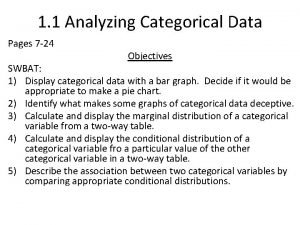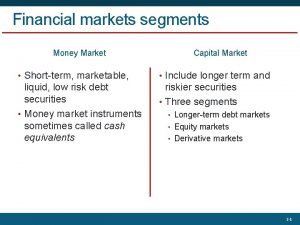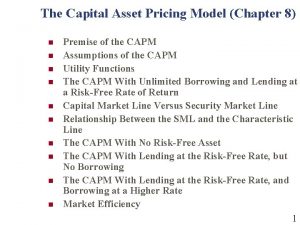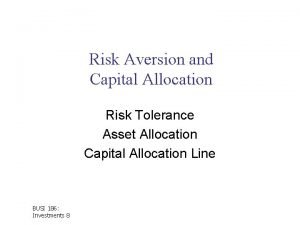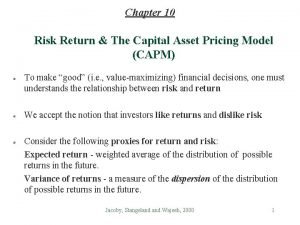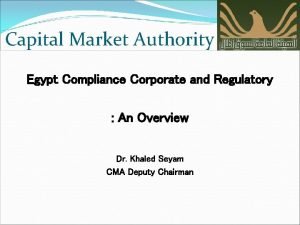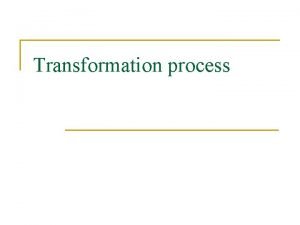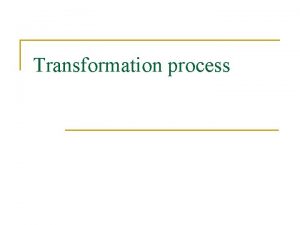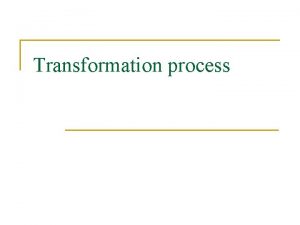2014 2024 Capital Market Transformation Plan Capital Market


































- Slides: 34

2014 – 2024 Capital Market Transformation Plan Capital Market Master Plan Committee

TERMS OF REFERENCE 1. Review the implementation progress of “Nigeria’s Capital Market: Making World Class Potential a Reality” and outline milestones yet unachieved. 2. Conduct a holistic review of peer emerging markets with a view to articulating the requisite element, size and structure of a capital market that will enhance the global competitiveness of the Nigerian capital market and catalyze Nigeria’s potential to become the largest economy in Africa within the focused period. 3. Examine successful growth strategies in other jurisdictions and articulate a development strategy for the Nigerian capital market covering key areas such as investor protection and education, professionalism, product innovation and expansion of the role of the capital market in economic development. 4. Consider relevant factors that impact market growth and develop a strategy for robust governance for improved efficiency, transparency and enhancement of market stability. 5. Make necessary recommendations with clear and actionable quarterly and annual milestones that will lead to a world class capital market which supports an inclusive economy and improves the living standard of Nigerians.

Contextual Background The committee’s mandate is to articulate a 10 -Year (2014 – 2024) Strategic Master Plan for the Nigeria Capital Market Industry. Work done so far § Conducted current position assessment exercise along the following areas: - Market Structure - Contribution to National Economy - Regulation and Oversight - Competitiveness Output § Key Issues and Challenges of the Nigerian Capital Market § Implications and Strategic Considerations § 2024 Vision and strategic objectives

Summary of Issues from Current Position Assessment 4

Nigeria Capital Market Key Metrics Market Cap as a % of GDP 50. 0% 40. 0% 247% 207% Sectors as a % of GDP (2012) 38. 2% Sectors as a % of NSE Mkt Cap (2012) 30. 0% 20. 0% 14. 8% 112% 7. 0% 10. 0% 0. 1% 2. 0% Agriculture Oil & Gas 27% 0. 0% Malaysia South Africa 250. 0% Brazil 188. 2% 127. 3% 150. 0% 67. 9% 50. 0% 56. 3% 114. 5% 98. 1% 51. 0% 10. 1% 0. 0% Brazil China India Nigeria Russia South Africa US Asset Class Portfolio Limit BRICS Avg. Portfolio Amount Assets In Issue (bn) 3. 2% 1. 0% Telecomms Construction / Real Estate 2013 Equities Market Turnover Ratio (%) 200. 0% 100. 0% Nigeria 0. 5% % of PFA Asset FGN Bonds 80 % 3, 172 2, 371 59. 79% State Government Bonds 20% 793 205 5. 17% Corporate Bonds* 35% 1, 388 83 2. 10% Supranational Bonds 20% 793 0 0. 04%

Key Issues & challenges of the Nigerian Capital Market Contribution to National Economy Regulation and Oversight § Limited size, depth, reach and sophistication of the Capital Market § Liquidity constraints § Structural challenges and regulatory constraints limit access to Pension Funds that contribute significant portion of long term investable funds in the economy § No national strategy (regulation and incentives) for long term savings and investments § Non-supportive policy making framework to facilitate growth of capital market § Uncompetitive pricing (transaction costs and cost of funds) § Restrictive that does not support growth and is not flexible Processingregulation time to keep pace with changes in the capital market § No clear regulatory/oversight themes around liquidity and risk § Perception that regulator is administrative in orientation and focus on penalties § Independence and autonomy of regulator § Regulatory capacity, dearth of skills and knowledge, low level of technology is limiting compliance and enforcement § Absence of regulator driven market infrastructure standards for self regulatory bodies § Limited capacity for statutory oversight of Self Regulating Organisations and Trade Groups 6

Key Issues & challenges of the Nigerian Capital Market Structure Competitiveness § Market fragmentation and scale § Limited market concentration - Predominantly equities market § Market capitalisation and activity concentrated in few economic sectors and stocks § Market practices and structures have not kept pace with development § Archaic practices – requirement for physical share certificates vs dematerialisation of shares § Suboptimal skills and low level of IT assimilation/ capacity to leverage IT to transform and modernise operating model § Uncompetitive pricing of primary and secondary market processes and transactions § Multiple transaction payment points § Lengthy turnaround time for transaction applications; open-ended timelines § Poor dispute resolution process / mechanism § Quality and reliability of market research and information about securities and corporate performance § Adequacy of processes for identifying, terminating and correcting market manipulation § Weak transparency in trading practices of market operators (equity and fixed income) § Limited oversight and surveillance capability on electronic trading platforms 7 § Quality and Enforcement of whistle blowing mechanism

Overall Strategic Considerations for Nigeria’s Capital Market 8

Overall Strategic Considerations – Key themes 1. Increase Capital Market Scale, Economic Relevance & Sophistication − − Fund critical transformation of Power, Infrastructure, Oil and Gas, telecommunications Close gap in current proportion of capitalisation to GDP and keep pace with projected annual GDP growth of +7% From narrow to broad market Diversify product offerings 2. Improve Market Competitiveness and Attractiveness − − − Borderless market to foster globalisation Attractive and transparent market Foster constructive competition Improve cost competitiveness of transactions Ease of access and cost of capital funds Vibrant and competitive industry for savings and investment 3. Establish Market Enabling Regulatory framework − − − Risk based monitoring and supervisory framework Regulatory framework focus on market development and modernisation More effective integration among FS regulators

Overall Strategic Considerations – Key themes 4. Market Liquidity, Depth and Sophistication − − − Deepen source of funding the critical economic sectors and development Innovative, market relevant product innovation and development Strategic collaboration with global markets 5. Capability, competence and scale of Operators − − Scale and Capacity of market operators Skill and talent for innovation and competitiveness Cost effective operating models Modernise marketing, distribution and fulfillment channels 6. Modernisation of Market Infrastructure and Channels − − World class Clearing and Exchange platforms Attractive and transparent market processes and transactions

Overall Strategic Considerations – Key themes 7. Improving Processes and Efficiency − − − Efficiency of the trading, clearing and settlement Automation of regulatory and transaction processes Responsive regulatory processes and approvals 8. Growing long term savings investments − − Market relevant savings and investment programs to encourage long term savings Financial Inclusion and Financial literacy programs

Nigeria Capital Market 2024 Vision and Objectives 12

Vision Elements Growth Relevance Robustness Size 2024 Nigerian Capital Market Vision Regulatory Framework

Vision Statement “To be Africa's most modern, efficient and internationally competitive market that catalyzes Nigeria’s emergence as a top 20 global economy. ”

2024 Vision – Contribution to National Economy Objective: Support and facilitate capital raising for sustainable national development and transformation of Nigeria’s priority economic sectors. § Functional size in terms of GDP, breadth of sectors, number of SIZE participants, listed instruments, corporate bonds and national savings ratio targets § Adequate and greater representation of all key sectors of the broader economy § Liquid and efficient market for the secondary trading of securities § Inclusive plan to develop the corporate bond market as a preferred source of funding for Nigerian companies § Primary source of funding for infrastructural and high impact development RELEVANCE projects § Strong framework for corporate governance and shareholder value recognition § Effective investment management industry and conducive environment for investors

2024 Vision – Contribution to National Economy Objective: Support and facilitate capital raising for sustainable national development and transformation of Nigeria’s priority economic sectors. § Strategic alliance with peer exchanges to exploit synergic advantages § Leverage ICT to improve market operations and efficiency § Product diversification to boost investment and cater to various risk. SOPHISTICATION return profiles § Flexible business architecture and strategies for operators and exchanges § Robust market in terms of volatility rate § Strong Derivative market – range of risk to cover and mitigate

2024 Vision – Capital Market Regulation and Oversight Objective: An enabling and facilitative regulatory framework supportive of the deepening and development of the Nigeria Capital market as well as increases the level of investors’ confidence. § Strengthen financial reporting and disclosure by firms in terms of ranking REGULATORY FRAMEWORK (e. g. World Economic Forum) § Develop a robust regulatory framework particularly in the areas of risks (credit, liquidity, market and systemic risk § Strengthen transparency of and compliance with its code of ethics and the Code of conduct § Flexible and facilitative regulatory framework which supports innovation and development of the market ENABLING RGEULATION § Implement strong enforcement and extensive surveillance of activities in the Capital market § To have a clearly defined regulatory scope reflecting the definition of capital market § Ease of doing business and turn around or processing time

2024 Vision – Market Structure Objective: An enabling and facilitative regulatory framework supportive of the deepening and development of the Nigeria Capital market as well as increases the level of investors’ confidence. EFFICIENCY MODERN MARKET § Reduce market transaction costs § Defined regulatory model for market development and growth § Deepen market capacity § Turnaround time § Cost of doing business § Modernize the practices and structure of capital market § Market sophistication § Develop a large pool of highly skilled investment management professionals to foster greater innovation and competition – in terms of number of certified professionals in the industry

2024 Vision – Competitiveness Objective: World class capital market with competitive practices to ensure transparency, efficiency and liquidity for effective mobilisation of local domestic savings and investments, attract sustainable investments in the critical sectors of Nigeria’s economy § Investor access to vibrant and competitive investment industry – investor ATTRACTIVE MARKET confidence ranking § Develop an attractive and transparent market § Higher competitiveness ranking § Straightforward, efficient and strong investor protections

Next Steps • Incorporate comments and feedback from CMPC • Refine strategic objectives and define performance measures • Organise 3 -day Technical retreat in April for technical committee and representatives from CBN, DMO, PENCOM, NAICOM, 4 -5 banks (investment/merchant banks) − Cascade strategic objectives to measurable targets − Define programmes and initiatives towards the achievement of objectives • Document retreat outcomes and articulate the 10 -year strategic plan for the Nigerian Capital Market

Appendix

Current State Assessment – Contribution to National Economy Size Small, weak and insignificant for the needs of the economy Narrow, Unsophisticated offerings Uncompetitive Pricing - Transaction Costs - Cost of Funds § Current size limits relevance and role in the national economic 132% development Average size of § Only a fraction of the GDP – 27% the capital markets of peer § Limited representation on the NSE of the key sectors in the economies relative to GDP broad economy – Telecommunications, Oil and Gas, Agriculture § Not positioned and does not have the scale to be relevant in the key sectors critical for economic development – Power, Real Estate § Infrastructure, Limited product offering particularly to support infrastructural development projects § Lack of a derivatives market to provide the desired economic functions of: risk management, price discovery and transactional efficiency § Inadequate fund management capabilities to drive investment funds like unit trusts § High cost of primary as well as secondary processes– transaction fee for both equities and bonds are relatively high § Risk free return rate (MPR above single digit) reduce attractiveness of corporate bonds for both issuers and investors 0. 1% Average Transaction fee in peer economies 22

Current State Assessment – Contribution to National Economy Liquidity Banking Sector Dominance of Financial Services Industry § Limited market liquidity § N 145. 7 B CIS funds grossly inadequate to drive liquidity in the market § Ability to competitively attract and grow long term savings and investments o Banks are the primary repository of savings in the country o Tiered KYC for financial inclusion o Bank deposit remain viable investment outlets for both retail & institutional investors in Nigeria § Relative Ease of access to Bank Funding § Deeper relationships and industry knowledge $26 Million Average daily trading volume N 6. 5 Trillion Cumulative bank loans to the private sector N 2. 05 Trillion Bond mkt cap (excluding FGN) § Length of time it takes to bring an issue to the market Processing Time o New debt issue takes an average of 6 months from appointment to closure of transaction o Time lag is usually due to SEC’s procedures and sometimes, lack of organization on the part of the issuer § Theo prolonged time has led towhich Issuescould being susceptible Significanttransaction changes in market condition make the issue to: unattractive o Issuers often lose interest in the transaction and seek alternative sources of funding 23

Current State Assessment – Contribution to National Economy Opportunities in Pension limited by current regulations § Structural challenges and regulatory constraints which limit access to Pension Funds that contribute significant portion of long term investable funds in the economy § Limitations in sophisticated products that appeal to pension capital market investments § Poor incentives to encourage capital market investments especially for new entrants into pension accounts i. e. high risk capacities $26 Million Average daily trading volume 24

Strategic Considerations – Contribution to National Economy How can the Capital Market achieve the necessary scale and sophistication to be relevant in the transformation of the economy and achievement of national development aspirations? - Size relative to GDP - Contribution to Priority Economic Sectors - Funding Structure and Cost - Product Sophistication - Liquidity and Depth - Cost Competitiveness

Current State Assessment – Capital Market Regulation and Oversight • Rules Based Framework • Perception that SEC as regulator is administrative in orientation and focus on penalties - - Current rules and regulations are restrictive and burdensome Rules have not adapted and is not flexible to keeping pace with changes in the capital market and clear regulatory/oversight themes “revenue and earnings’ priority vs market development and enablement • Regulatory effectiveness is lagging • Regulatory capacity, dearth of skills and knowledge, low level of technology is limiting compliance and enforcement 26

Current State Assessment – Capital Market Regulation and Oversight • Rigour of and regulatory capacity vary and financial system regulators operate in silos with limited information sharing - Different methodologies for supervisory activities Limited effectiveness of cross-regulator oversight • Financial services companies with cross sector operations potentially pose regulatory complications as Nigerian regulatory institutions are not strong and sophisticated enough to undertake joint and complementary regulation • Absence of regulator driven market infrastructure standards for self regulatory bodies • Limited capacity for statutory oversight of Self Regulating Organisations and Trade Groups 27

Strategic Considerations – Capital Market Regulation and Oversight How can the regulation and oversight regime facilitate enabling environment for growth and world class capital market? - Regulatory and Oversight Framework - Responsiveness to market specific context and clear regulatory themes and guiding principles - Effectiveness of regulatory surveillance and compliance - Effectiveness of cross sector regulation - Capacity for compliance, enforcements and surveillance - Standard, enforceable conduct code - Technology leverage for improved surveillance and compliance

Current State Assessment – Market Structure Operators Market Practices and Structures Market Concentration § Market capacity and liquidity constraints due to fragmentation and capacity of market participants § Low level of IT assimilation/ capacity to leverage IT to transform and modernise operating model § Suboptimal skills § Practices and structures have not kept pace with development § Archaic practices – requirement for physical share certificates vs dematerialisation of shares § Limited portion of shares in issue are transferable § Registrars and issuing houses § Predominantly equities market § Market capitalisation and activity concentrated in few economic sectors and stocks 29

Current State Assessment – Market Structure Dearth of Product Offerings § § Low level of and unsophistication of Financial intermediation Predominantly equities market Debt securities and other offerings- derivatives are under developed Limited success of Collective Investments / special investment offerings § Evolving model of Exchanges for listing and trading activities Exchanges and Market Infrastructure o o Equities Debt Securities – Federal Government vs State Government + Corporates Currency Commodities § Absence of regulator defined industry standards for exchanges, market infrastructure and Operators’ Capabilities Technology Leverage § Limited use of technology for innovation and development of specific value- added areas/content § Capacity of operators to invest in technology 30

Strategic Considerations – Market Structure How can the Capital Market transform practices and structure to modernise and deepen capacity? - Sophistication and breadth - Capacity of operators - Market Diversification - Market and Exchange Infrastructure - Market practices and processes - Platform and Oversight for Trading Government Securities - Financial Inclusion - Dematerialization of Shares - Technology Leverage and Standards for Exchanges and Operators

Current State Assessment – Competitiveness Pricing § Uncompetitive pricing of primary and secondary market processes and transactions § Multiple transaction payment points § Lengthy turnaround time for transaction applications; open-ended Capital Market Processes Transparency timelines § Manual and cumbersome filing process: requirement for multiple physical documents. § Lengthy trade settlement process § Poor dispute resolution process / mechanism § Completeness, reliability and timeliness of disclosure of material information including Director and Director Related Activities, significant shareholdings - visibility of direct and indirect holdings § Quality and reliability of market research and information about securities and corporate performance § Adequacy of processes for identifying, terminating and correcting market manipulation § Weak transparency in trading practices of market operators (equity and fixed income) § Limited oversight and surveillance capability on electronic trading platforms § Quality and Enforcement of whistle blowing mechanism 32

Current State Assessment – Competitiveness § Oversight and enforcement of compliance with corporate governance Governance code § Regulatory oversight and capacity for enforcement of rules § Lack of coordination among regulators – SEC, NSE, CBN, Pen. Com, NAICOM and FRC § Low technology leverage and Capacity and Operating Models ability to invest in technology to improve productivity by market operators § Relative absence of disaster recovery and business continuity systems (operators) § Predominantly physical channels § Absence of market infrastructure service providers § Unsophisticated, manual operating models 33

Strategic Considerations – Competitiveness How can the Capital Market become more competitive and diversify to meet the intermediation requirements of the nation’s growing economy by improving mobilisation and allocation of funds within the domestic market, and attract global investors to Nigeria? - Transaction pricing model for primary and secondary processes - Technology standards and technology enabled processes - Cost of Capital and Debt - Reliability of market information and reporting - Market survellance and enforcement capabilities
 Pne 2014-2024
Pne 2014-2024 Medium term strategic framework
Medium term strategic framework Arah kebijakan pembangunan kesehatan tahun 2020-2024
Arah kebijakan pembangunan kesehatan tahun 2020-2024 2024 aasta suveolümpiamängud
2024 aasta suveolümpiamängud Why do statisticians prefer bar graphs
Why do statisticians prefer bar graphs Smart asn 2024
Smart asn 2024 Renstra kkp 2020-2024
Renstra kkp 2020-2024 Capital allocation line vs capital market line
Capital allocation line vs capital market line Money market capital market
Money market capital market Capital market and money market
Capital market and money market Plan nacional de desarrollo 2010 a 2014
Plan nacional de desarrollo 2010 a 2014 Cuanto gana un platino en amway
Cuanto gana un platino en amway Market leader follower challenger nicher
Market leader follower challenger nicher International marketing segmentation
International marketing segmentation Health sector transformation plan ii ethiopia
Health sector transformation plan ii ethiopia Better health together spokane
Better health together spokane Net working capital refers to which of the following
Net working capital refers to which of the following Source of capital reserve
Source of capital reserve Multinational cost of capital and capital structure
Multinational cost of capital and capital structure Difference between capital reserve and reserve capital
Difference between capital reserve and reserve capital Regulatory capital vs economic capital
Regulatory capital vs economic capital Regulatory capital vs economic capital
Regulatory capital vs economic capital Constant capital and variable capital
Constant capital and variable capital Multinational cost of capital and capital structure
Multinational cost of capital and capital structure Capital market line
Capital market line Capital market line
Capital market line Homemade leverage upsc
Homemade leverage upsc Portfolio weights
Portfolio weights Calculate expected portfolio return
Calculate expected portfolio return Structure of indian capital market
Structure of indian capital market Capital market development authority
Capital market development authority Importance of capital market
Importance of capital market The following are advantages of the sml approach
The following are advantages of the sml approach Capital market authority egypt
Capital market authority egypt Yang fin
Yang fin




